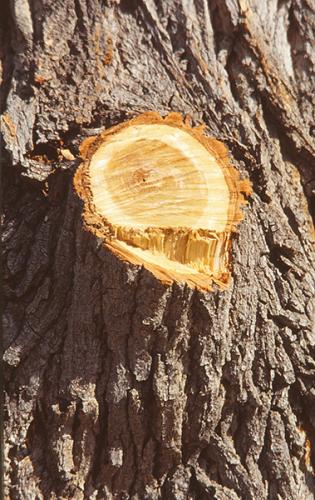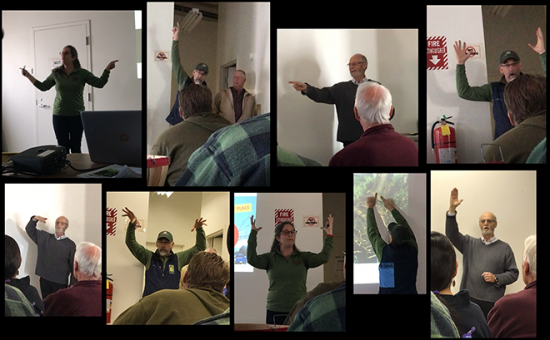March 6, 2021
Pruning Answers: Long Story Short
It’s that time again when pruning workshops fill horticultural calendars. This year, many workshops are being offered virtually. The Santa Fe Botanical Garden will offer a virtual fruit tree pruning workshop with arborist Tracy Neal and Head Gardener Linda Churchill at 11 am on Tuesday, March 9. Register at https://santafebotanicalgarden.org/. The NMSU Sustainable Agriculture Science Center at Alcalde is offering their Annual Fruit Grower Workshop virtually from 9 am - 12 pm March 11 & 12. Register for this event at https://alcaldesc.nmsu.edu/. And I’ll be presenting “Pruning Basics” at 3 pm on March 17 for the NMSU gardening webinar series Ready, Set, GROW! Register at https://desertblooms.nmsu.edu/ready-set-grow.html.
In-person demonstrations are better for teaching and learning pruning techniques, but we’re all doing the best we can. To make my virtual rose pruning webinar feel more like a regular workshop, I promised to stab myself with a rose thorn and shout, “SUGAR!” Just like the good old days.
This week, I picked several common pruning questions and pulled tidbits from various NMSU online resources. Check out the blog version of the column for more resource links (https://nmsudesertblooms.blogspot.com). I’ll also post other upcoming workshops as I hear of them.
How does ornamental tree pruning differ from fruit tree pruning?
Answered in NMSU Extension Guide H-156: Tree Pruning Techniques by Dr. Curtis Smith.
“… The purpose of pruning in an orchard is to maximize economic return and stimulate early fruit production. Landscape tree pruning is usually intended to maintain a tree’s natural form, health, and longevity and to minimize hazards that develop from improper pruning and unrestricted branch growth. Pruning to reduce a tree’s size is sometimes necessary but often indicates that the wrong tree was selected for the specific landscape site. If size-reduction pruning is needed in landscape trees, follow the proper pruning information provided in this publication to minimize reduction in tree health and prevent development of hazardous branches and poor branch attachment that can result in property damage or personal injury…”
When should I prune my fruit tree?
Answered in NMSU Extension Guide H-327: Pruning the Home Orchard by Dr. Shengrui Yao.
“… Most pruning is done during the dormant season in late winter or spring, just before active growth begins. In north and central New Mexico, February to early March would be good time to prune. At this time, pruning wounds heal fast, flower buds are easily recognized, and injury from low winter temperatures may be avoided. In some areas, due to disease pressure, peaches have to be pruned after leafing, but not in New Mexico.
Pruning is also done in summer to train young trees to the desired shape, remove watersprouts and other undesirable growth, and maintain smaller tree size…”

When should I prune my grapevines?
Answered in NMSU Extension Guide H-303: Pruning Grapes to the Four-Arm Kniffin System by Dr. Gill Giese.
“… Dormant grapevine pruning is a critical viticultural operation that removes 80 to 90% of the current season’s growth, and is the primary means of regulating crop production in the subsequent season. Light or minimal pruning results in many growing points, weak shoot growth, many small clusters and berries, and poor annual wood maturation. Heavy or severe pruning, leaving few growing points overall, results in excessively vigorous shoot growth, and fewer fruit clusters with relatively large berries. The successful grape grower prunes to direct vine growth to the desired trellis system and to optimize yield and quality over many years…”
Should I prune my newly-planted trees?
Answered in NMSU Extension Guide H-605: Training Young Pecan Trees by Dr. Richard Heerema.
“… The first five years of a pecan tree’s growth are the most important for developing canopy branch framework. Structural developments in the tree during these years will be evident for the rest of the tree’s life. There are few things pecan growers can do that have longer-lasting effects in an orchard than training young trees. The development of the tree structure should be done carefully with a minimal amount of pruning…”
Why not use pruning sealer?
Answered by Dr. Curtis Smith in an archived Southwest Yard & Garden (SWYG) February 10, 2001 column.
“… It does seem counter to common sense to leave a wound uncovered when we consider it from a human perspective. That is the way we tend to think about wounds, but remember a tree is not a human, or even an animal, and responds to things in a different manner. In the natural environment, branches break from trees in wind storms and must have a mechanism to defend themselves without a gardener going into the forest and applying wound sealer to every injury. Certainly, some of these cause problems for the tree, but in many cases the tree has the natural defense mechanisms to manage the problem…
“Scientific research has shown that the pruning sealer is not necessary. Much more important is proper pruning technique. Knowledge of tree anatomy and physiology allows us to prune a tree and allow the tree to use its protective mechanisms to protect itself. It is also wise to minimize pruning in landscape trees by training a tree when it is young. Cutting small branches when the tree is young precludes the necessity to cut larger branches later. The large wounds produced by removing large branches create greater difficulties for the tree.”
Visit our 25 years of NMSU Southwest Yard & Garden column archives.

Marisa Y. Thompson, PhD, is the Extension Horticulture Specialist, in the Department of Extension Plant Sciences at the New Mexico State University Los Lunas Agricultural Science Center, email: desertblooms@nmsu.edu, office: 505-865-7340, ext. 113.
Links:
For more gardening information, visit the NMSU Extension Horticulture page at Desert Blooms and the NMSU Horticulture Publications page.
Send gardening questions to Southwest Yard and Garden - Attn: Dr. Marisa Thompson at desertblooms@nmsu.edu, or at the Desert Blooms Facebook page.
Please copy your County Extension Agent and indicate your county of residence when you submit your question!